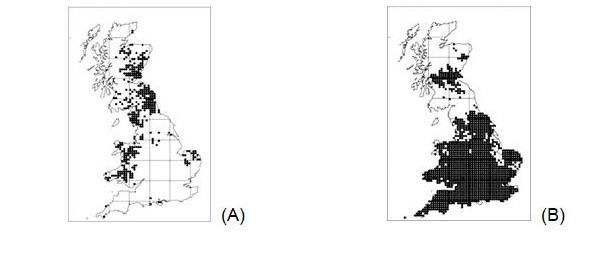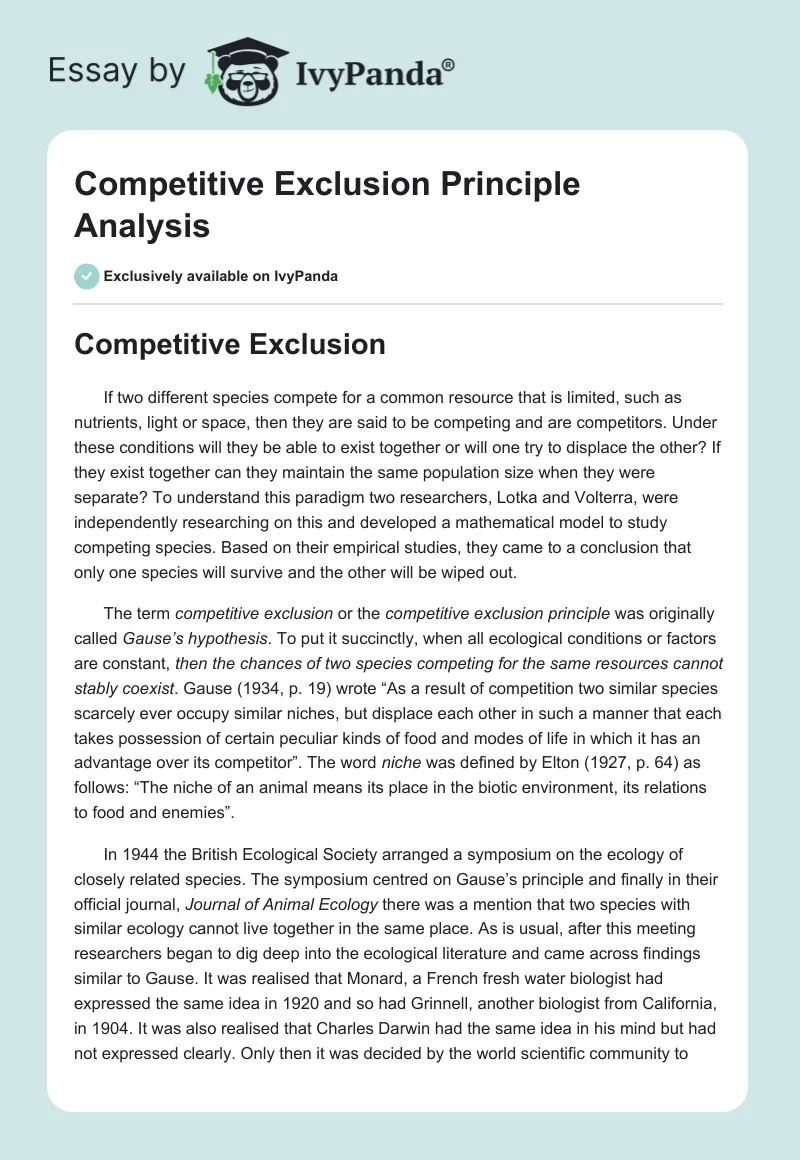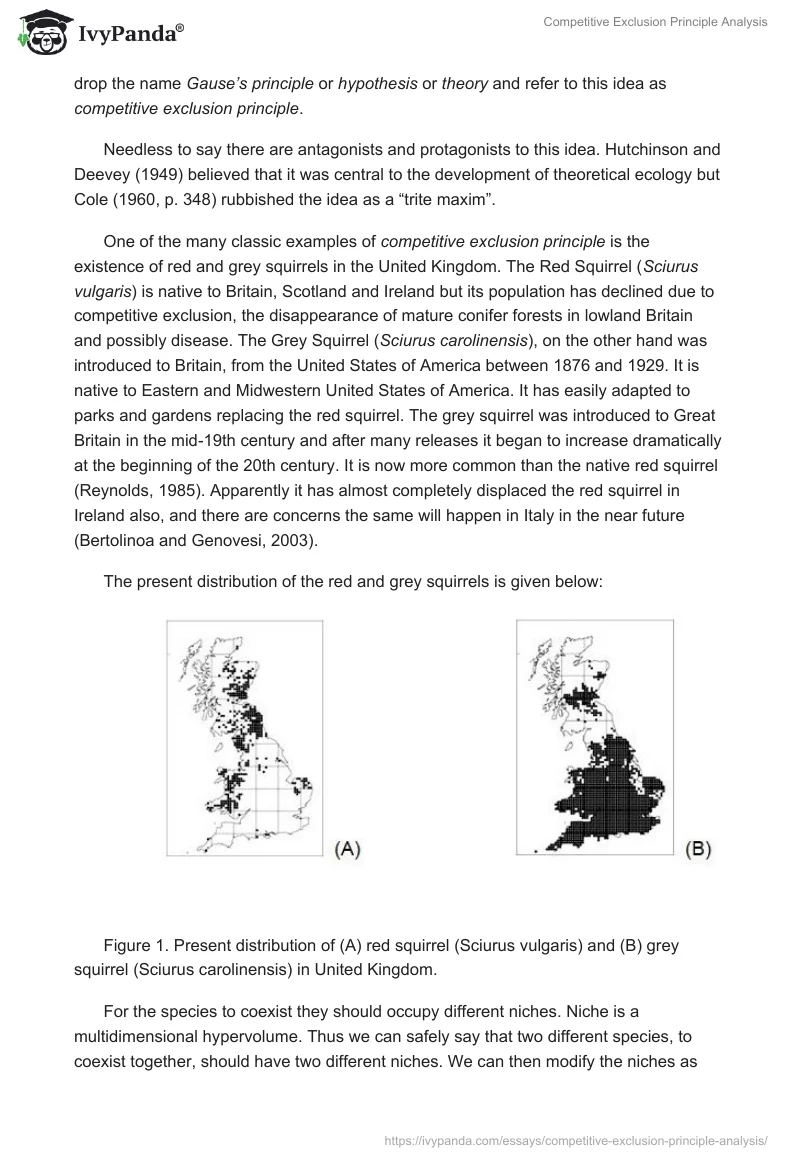Competitive Exclusion
If two different species compete for a common resource that is limited, such as nutrients, light or space, then they are said to be competing and are competitors. Under these conditions will they be able to exist together or will one try to displace the other? If they exist together can they maintain the same population size when they were separate? To understand this paradigm two researchers, Lotka and Volterra, were independently researching on this and developed a mathematical model to study competing species. Based on their empirical studies, they came to a conclusion that only one species will survive and the other will be wiped out.
The term competitive exclusion or the competitive exclusion principle was originally called Gause’s hypothesis. To put it succinctly, when all ecological conditions or factors are constant, then the chances of two species competing for the same resources cannot stably coexist. Gause (1934, p. 19) wrote “As a result of competition two similar species scarcely ever occupy similar niches, but displace each other in such a manner that each takes possession of certain peculiar kinds of food and modes of life in which it has an advantage over its competitor”. The word niche was defined by Elton (1927, p. 64) as follows: “The niche of an animal means its place in the biotic environment, its relations to food and enemies”.
In 1944 the British Ecological Society arranged a symposium on the ecology of closely related species. The symposium centred on Gause’s principle and finally in their official journal, Journal of Animal Ecology there was a mention that two species with similar ecology cannot live together in the same place. As is usual, after this meeting researchers began to dig deep into the ecological literature and came across findings similar to Gause. It was realised that Monard, a French fresh water biologist had expressed the same idea in 1920 and so had Grinnell, another biologist from California, in 1904. It was also realised that Charles Darwin had the same idea in his mind but had not expressed clearly. Only then it was decided by the world scientific community to drop the name Gause’s principle or hypothesis or theory and refer to this idea as competitive exclusion principle.
Needless to say there are antagonists and protagonists to this idea. Hutchinson and Deevey (1949) believed that it was central to the development of theoretical ecology but Cole (1960, p. 348) rubbished the idea as a “trite maxim”.
One of the many classic examples of competitive exclusion principle is the existence of red and grey squirrels in the United Kingdom. The Red Squirrel (Sciurus vulgaris) is native to Britain, Scotland and Ireland but its population has declined due to competitive exclusion, the disappearance of mature conifer forests in lowland Britain and possibly disease. The Grey Squirrel (Sciurus carolinensis), on the other hand was introduced to Britain, from the United States of America between 1876 and 1929. It is native to Eastern and Midwestern United States of America. It has easily adapted to parks and gardens replacing the red squirrel. The grey squirrel was introduced to Great Britain in the mid-19th century and after many releases it began to increase dramatically at the beginning of the 20th century. It is now more common than the native red squirrel (Reynolds, 1985). Apparently it has almost completely displaced the red squirrel in Ireland also, and there are concerns the same will happen in Italy in the near future (Bertolinoa and Genovesi, 2003).
The present distribution of the red and grey squirrels is given below:

For the species to coexist they should occupy different niches. Niche is a multidimensional hypervolume. Thus we can safely say that two different species, to coexist together, should have two different niches. We can then modify the niches as feeding niches, breeding niches etc. As and when the terms in the ecological literature grew, finer explanations came into existence. Whittaker et al. (1973) fine tuned these concepts further by saying that niche meant the role of an organism within a community and habitat was the range of environments in which a species occurs. In short, niche defines a narrow spectrum of space whereas habitat is essentially a distributional concept.
Now that we have defined a niche, we are tempted to ask if two competing species can occupy the same niche. Before we proceed any further we must realise that every hypothesis has its own limitations and we should be careful to set down at the beginning some situations in which competitive exclusion would not be expected to function. Hutchinson (1958) has mentioned about the situations as follows: 1) environments that are unstable and never reach equilibrium and in which colonising species coexist; 2) environments in which there is no need for the species to compete for resources and finally 3) environments that are fluctuating and reverse the direction of competition before extinction is possible.
Field ecologists have always observed a vast number of closely related plant and insect communities living in close quarters; and this seems to be an ecological paradox. If the same species that can coexist in field communities, why do they go extinct in laboratory conditions? Two simple views emerge from this question. One states that competition is rare in nature (since species are not competing for limited resources) and the other that competition is common enough to be a major factor guiding the evolution and development of species in a community.
A lot of research has happened till now and has attempted to test competitive exclusion principle and understand the very nature of competition itself. David Lack, the British ornithologist, began to study two closely related species; namely the cormorant (Phalacrocorax carbo) and the shag (Phalacrocorax aristotelis). It is interesting to note that they occupy similar habitats, have similar habits and appear to overlap widely in their ecological requirements. They both nest in cliffs and eat fish. Then how do they survive? The answer to this was given by Lack (1944, 1945) himself. He found that the cormorants nest chiefly on flat, broad cliff ledges and feed in shallow estuaries whereas the shag’s requirement was different. Shags nested on narrow cliff ledges and feed mainly at sea. Thus there were a lot of dissimilarities and ecological differences between these two closely related species and thus competition was reduced.
Lack further suggested, based on this and other studies that these differences arose because of competition in the past between these closely related species. Thus competition exclusion principle and its associated selection pressure ensured that either species ‘moved’ away from each other to avoid competition. Since then a lot of research has been done to know more about competition and the pressure it exerts on the evolution of species. Competition drives evolution in a way that it leads to speciation.
MacArthur (1972) realised that the nature of intense competitive interactions found in nature should have shaped the evolution of species differences. He essentially turned around the competitive exclusion principle and asked a very valid but simple question. “If complete competitors cannot coexist, how different do two species have to be in order to coexist in the same habitat? (Krebs, 1985, p. 261). Needless to say that species that compete will evolve ecological or morphological differences to minimize the effect of competition.
“One evolutionary consequence of competition between two species has been the divergence of the species in areas they occur together. This sort of divergence is called character displacement” (Krebs, 1985, p. 267). This can arise due to two reasons. One, if two closely allied species have to maintain reproduction isolation some dissimilarities between them has to evolve to show up reproductive barriers. Secondly, interspecific competition may cause divergence. A classic example of character displacement is found in the Darwin’s finches found on the Galapagos Islands. Arthur (1982) opines that in order to qualify for the conclusion that Darwin’s finches are good examples of evolutionary changes due to competition, four of the following criteria must be met:
- There should be concrete evidence to prove that the species are indeed competing and that the characteristics measured must has some relevance to the competitive process.
- Sampling should be done randomly at a variety of locations so that local effects are eliminated.
- The change in mean value of the character in areas of overlap should not be predictable from the variation within areas of overlap or isolation.
- Heritability of the character must be estimated to be high so that genetic variation may be said to underlie the differences observed.
“For Darwin’s finches, only criteria 3 and 4 are satisfied. The change in beak size in Geospiza fortis in isolation on Daphne Islands, for example, is much greater than one would predict from observed variation on any of the other islands. Beak characters in G. fortis have a very high heritability (Boag and Grant, 1978), which suggests that the variation in beak depth in Geopsiza is largely genetic in origin. Unfortunately, because of the finite size of the Galapagos Islands, we cannot replicate these findings in another set of islands (criterion 2), and there is as yet no definitive evidence of competition for food in Darwin’s finches (criterion 1).
There are at present few cases in which character displacement has been conclusively demonstrated. We do not know whether this means that character displacement rarely occurs or that it is common but very difficult to demonstrate in natural populations” (Krebs, 1985, p. 269).
In conclusion, let us emphasise that that there are two types of completion; interspecific and interspecific. Interspecific is between species and interspecific is within species. Lot of research has gone in understanding the mechanisms that drive these ecological variables. The example of the well studied Anolis lizard, reproduced below, sheds some light on these two competitions.
“Population experiments with Anolis lizard species demonstrate a relation between the amount of between-species competition and the degree of interspecific resource partitioning (the more the partitioning the less the competition). Specifically, the amount of resource partitioning between the two species (Anolis gingivinus and Anolis wattsi pogus) on the island of St. Maarten is less than that between the two species (Anolis bimaculatus and Anolis wattsi schwartzi) on the island of St. Eustatius. The presence of Anolis wattsi both lowers the growth rates and raises the perch heights of Anolis gingivinus individuals. In contrast, Anolis wattsi has no effect on Anolis bimaculatus. Thus, when there is less resource partitioning, Anolis wattsi has a greater competitive effect. This verifies, for these species, a central assumption of competition theory: the strength of between-species competition is inversely related to the amount of interspecific resource partitioning.”
Thus we see that competitive exclusion, per se, is one of the ecological variables that cause species to adapt and evolve.
References
- Arthur, W. 1982. The evolutionary consequences of interspecific competition. Advances in Ecological Research. 12:127-187.
- Bertolinoa, S. and Genovesi, P. 2003. Spread and attempted eradication of the grey squirrel (Sciurus carolinensis) in Italy, and consequences for the red squirrel (Sciurus vulgaris) in Eurasia. Biological Conservation. 109:351-358.
- Cole, L. C. 1960. Competitive exclusion. Science. 132:348-349.
- Elton, C. 1927. Animal Ecology. Sidgwick and Jackson, London.
- Gause, G. F. 1934. The Struggle for Existence. Macmillan, New York.
- Hutchinson, G. E. 1958. Concluding remarks. Cold Spring Harbor Symposium. Quantitative Biology. 22:415-427.
- Hutchinson, G. E. 1959. Homage to Santa Rosalia or why are there so many kinds of animals? American Naturalist. 93:145-159.
- Hutchinson, G. E. and Deevey, E. S. Jr. 1949. Ecological studies on populations. pp. 325-359 in Survey of Biological Progress. Vol. 1. Academic Press, New York.
- Krebs, C. J. 1985. Ecology: The Experimental Analysis of Distribution and Abundance. 3rd edition. Harper and Row, New York.
- Lack, D. 1944. Symposium on “The Ecology of Closely Allied Species”. Journal of Animal Ecology. 13:176-177.
- Lack, D. 1945. The ecology of closely related species with special reference to cormorant (Phalacrocorax carbo) and shag (P. aristotelis). Journal of Animal Ecology. 14:12-16.
- MacArthur, R. H. 1972. Geographical Ecology. Harper and Row, New York.
- Pacala, S. and Roughgarden, J. 1982. Resource partitioning and interspecific competition in two two-species insular Anolis lizard communities. Science, 217:444-446.
- Reynolds, J. C. 1985. Details of the Geographic Replacement of the Red Squirrel (Sciurus vulgaris) by the Grey Squirrel (Sciurus carolinensis) in Eastern England. Journal of Animal Ecology. 54:149-162.
- Whittaker, R. H., Levin, S. A. and Root, R. B. 1973. Niche, habitat, and ecotope. American Naturalist. 107:321-338.


